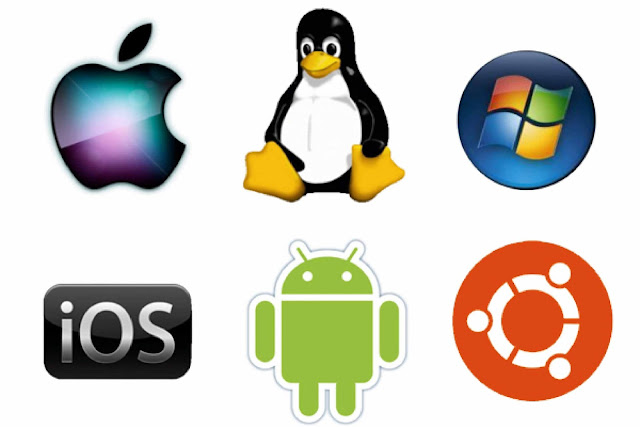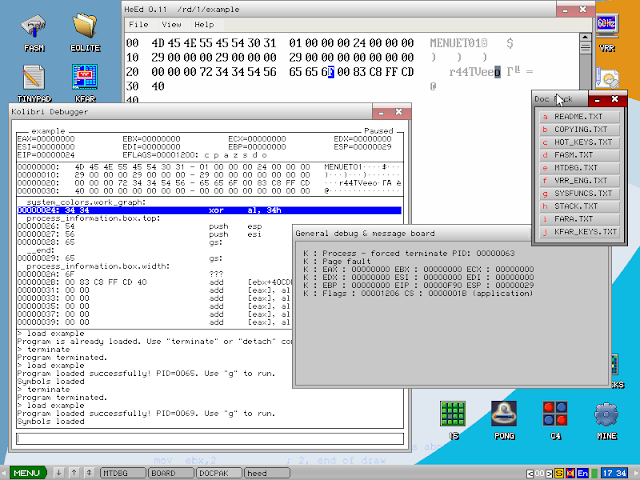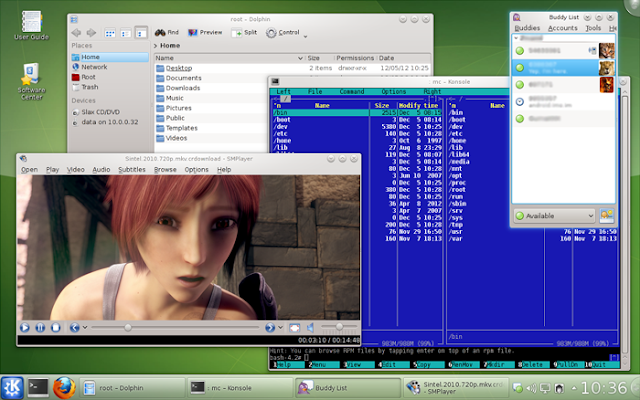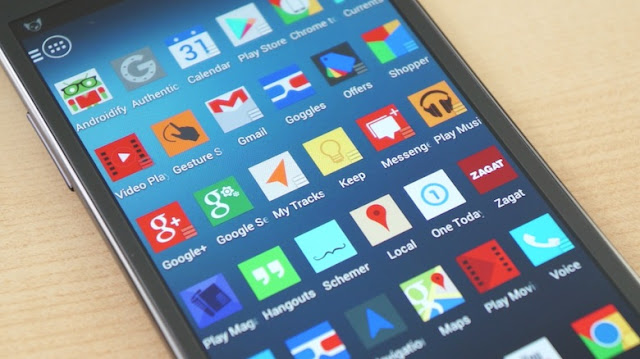Skip to main content
17 Operating Systems You May Not Have Heard Of (But Should) Grab Them Now!
Unknown Operating Systems you would not have heard about.
While the Operating System (OS) is the most important system software
powering the gadgets and devices we find under our fingers daily,
we’re mostly familiar with the regular few: Windows, Mac OS X, Linux,
and for mobile, iOS, Android OS, Windows OS, Blackberry OS, Symbian,
Bada etc.
 |
| Operaitng System |
But outside of these usual suspects there are many more operating systems –
big, small, easy, difficult, for general or very specific uses. Here’s 8
not-so-known operating systems you might find interesting.
These operating systems, though unknown to many, are unique and amazing software.
If you cannot install any of these OS you can try them with a flash
drive or via a virtual environment using VirtualBox or VMWare, which you
might after you find out what they have to offer.
1. KolibriOS: Smallest GUI OS
Kolibri is the smallest GUI operating system. It was forked off from MenuetOS. Written completely in assembly language, it is available in two versions: 1.44MB with essential features
and 3MB with additional features. Despite being small enough to fit in a
floppy disk, Kolibri is a complete and working graphical user
interface.
 |
KolibriOS
|
Kolibri can be booted using a floppy disk, optical disc, flash drive or
hard disk drive. It can read many file systems including FAT32, NTFS,
and EXT3/4. It has applications for all basic computing tasks, such as text editor, email client, HTTP client, etc.
2. Firefox OS: Mozilla’s Mobile OS
Mozilla has tried to bring a completely open source mobile platform. . Codenamed Boot2Gecko, Mozilla branded it under the name of Firefox OS after its popular and open source web browser, Firefox. It is built on open web standards such as HTML, CSS, and JavaScript.
 |
| Mozilla's Mobile OS |
It features an interface much like that of Android
having home screen, notification bar, etc. It doesn’t support native
apps, only web apps built using HTML5, CSS3, and JavaScript. One of the
interesting features of Firefox OS is that everything inside it is a web page running on its separate browser process, like contacts manager, dialer, etc.
3. Slax: Pocket OS
Slax is a modern, live, pocket
operating system based on Slackware Linux. Despite its small size of
220MB, it contains essential apps for basic computing, and you can extend its functionality using modules. Users can open a module (out of hundreds available e.g. Firefox, Libre Office) and the software will installed automatically.
 |
| Slax Pocket OS |
Being a live operating system, it can run directly from the portable drive
without the need of installation. You can just plug in your flash drive
(with Slax on it), configure system’s BIOS to boot from the flash drive
and voila, Slax boots up. It even features persistent storage, which means your data and preferences get saved in the flash drive, and are loaded automatically upon the next run.
4. AmigaOS 4.1
This month (September 2008) AmigaOS 4.1 was released. Although
AmigaOS is a veteran in the field (many have fond memories of the
original Amiga computer), its current version is a fully modern OS.
 |
| Amiga OS |
AmigaOS only runs on specific PowerPC-based hardware platforms. The company ACube is currently marketing and distributing AmigaOS and is going to bundle the OS with their motherboards.
5. Haiku
Haiku is an open source project aimed at recreating and continuing the development of the BeOS
operating system (which Palm Inc. bought and then discontinued). Haiku
was initially known as OpenBeOS but changed its name in 2004.
Haiku is compatible with software written for BeOS.
 |
| Haiku |
6. ReactOS
ReactOS is an operating system designed to be compatible with
Microsoft Windows software. The project started in 1998 and today it can
run many Windows programs well. The ReactOS kernel has been written
from scratch but the OS makes use of Wine to be able to run Windows applications.

7. Syllable Desktop
Syllable is a free and open source operating system that was forked in 2002 from AtheOS, an AmigaOS clone. It’s intended as a lightweight and fast OS suitable for home and small office users.
 |
| Syllable OS |
8. SkyOS
SkyOS is a closed source project written by Robert Szeleney and
volunteers. It originally started as an experiment in OS design. It’s
intended to be an easy-to-use desktop OS for average computer users.
Well-known applications such as Firefox have been ported to run on
SkyOS.
 |
| Sky OS |
9. MorphOS
MorphOS is a lightweight, media-centric OS build to run on PowerPC
processors. It is inspired by AmigaOS and also includes emulation to be
able to run Amiga applications.
 |
| Morph OS |
10. AROS Research Operating System
AROS is a lightweight open source OS designed to be compatible with
AmigaOS 3.1 but also improve on it. The project was started in 1995 and
can today be run on both PowerPC and IBM PC compatible hardware. It also
includes an emulator that makes it possible to run old Amiga
applications.
 |
| AROS |
11. MenuetOS
MenuetOS, also known as MeOS, is an operating system written entirely
in assembly language which makes it very small and fast. Even though it
includes a graphical desktop, networking and many other features it
still fits on a single 1.44 MB floppy disk (for our younger readers,
that was the USB stick of the 80s and early 90s).
 |
| MenuetOS |
12. DexOS
DexOS is an open source operating system designed to work like the
minimalistic ones on gaming consoles, but for PCs. Its user interface is
inspired by video game consoles and the system itself is very small
(supposedly this one also fits on a floppy disk, like MenuetOS) and the
OS can be booted from several different devices. Its creators have tried
to make it as fast as possible.
 |
| Dex OS |
13. Visopsys
Visopsys is a one-man hobby project by programmer Andy McLaughlin.
The development began in 1997 and the OS is both open source and free.
Visopsys stands for VISual Operating SYStem.
 |
| Visopsys |
14. Ubuntu for Phones: Content-focused UI
Ubuntu, the most popular desktop Linux distribution, is now available for phones under the name of Ubuntu for Phones, on top of Ubuntu for tablets, Ubuntu Server edition and Ubuntu Desktop. One of Ubuntu’s innovative features is that developers can write one app for all Ubuntu devices, which will be available via the Ubuntu Software Centre.
 |
| Ubuntu for Phone |
Ubuntu for Phones focuses on content rather than controls. It is designed to make your phone content easier to access – every edge of the screen has a specific purpose, making all your apps, content, and controls instantly accessible.
15. Tizen OS: Samsung’s replacement for Bada OS
Samsung relies heavily on Android for its smartphone market share,
but it’s trying to find alternative options. While it has the Bada OS, there are plans to replace the mobile OS on their smartphones with Tizen OS, an open source and standards-based software platform.
 |
| Tizen OS |
Tizen offers an innovative OS, applications, and user experience via flexible and powerful development environments based on HTML5.
Its smartphone technologies provide 3D window effects, multi-tasking,
multi-touch, sensor and location-based service frameworks, and support
for multiple screen resolutions.
16. Tails: Amnesic and Incognito OS
Tails is a Linux
distribution based on Debian. Tails stands for The Amnesic Incognito
Live System, and can be run (without installation) from portable mediums
such as optical disks and flash drives. As it is run entirely in the
computer’s RAM, all files and browsing history is automatically erased once the system is turned off (amnesic).
 |
| Tails |
Aimed at preserving your privacy and anonymity while browsing, Tails implements many security tools, including the Tor anonymity network, and cryptographic tools
to encrypt and secure your files, email, and instant messages to
protect your private information, including your identity (incognito).
17. Qubes OS: Security-by-Isolation OS
Qubes OS is based on Xen, X Window System and Linux. Qubes provide hardened security using the security-by-isolation
approach, creating many security domains, which are implemented as
lightweight Virtual Machines (VMs). These domains have their own set of
security restrictions, isolating one domain from the next.
 |
| Qubes OS |
So if you separate your browser from your sensitive work data, a
hacker or malware would not be able to access your information even if
it has compromised your browser, thanks to the isolated domains and
strategic compartmentalization. That’s the beauty of the security
implementation of Qubes OS.






Comments
Post a Comment